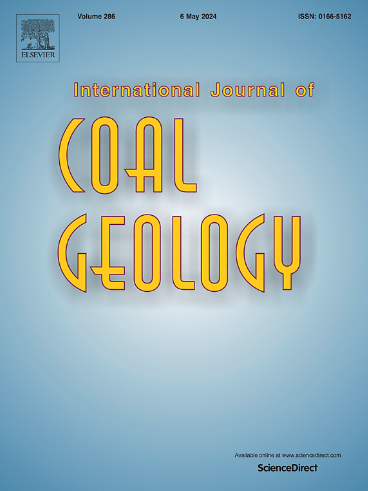Geochemistry and mineralogy of Permo-Carboniferous coals from the Fugu mining district, Shaanxi Province, China: Implications for the evolution of the northeastern Ordos Block
IF 5.7
2区 工程技术
Q2 ENERGY & FUELS
引用次数: 0
Abstract
The northeastern Ordos Block, a pivotal transition zone between the stable North China Craton and the reactivated Yinshan Orogenic Belt, preserves critical records of intra-cratonic responses to the closure of the Paleo-Asian Ocean. However, the Permo-Carboniferous tectonic evolution of the northeastern Ordos Block is debated due to the conflicting sediment source interpretations. This study reports the systematic geochemical and mineral characteristics of three coal seams (Nos. 9, 4, and 2 upward) of the Permo-Carboniferous period collected from the Fugu mining district, northeastern Ordos Block, China, and focuses on the evolution therein. The studied coal samples exhibited slight enrichments in Th, Zr, Hf, Ta, Li, and Ga compared with the word hard coals. The Al2O3/TiO2 ratio, Zr/Sc and Th/Sc plots, REY patterns, and Sr-Nd isotope analyses suggested that the elevated trace elements in three coals originated from the Benxi Formation bauxite in the northeastern Ordos Block. In the No. 9 coal (lower section of the Taiyuan Formation), the alteration in the provenance supply, as traced by variations of the high field strength elements (HFSEs), Al2O3 contents, Al2O3/TiO2 ratios, and presence of Al-hydroxides, indicated that the northeastern Ordos Block underwent a rapid and brief uplift during the early depositional period of the No. 9 coal, followed by a sharp subsidence, and finally a gradual uplift throughout the middle to late depositional periods. The medium–high sulfur content, high Sr/Ba ratio, and negative correlation between Sr/Ba and ash yields in the No. 9 coal reflected a mixed intrusion of freshwater and seawater to the Ordos Block during this period. In the No. 4 coal (lower section of the Shanxi Formation), relatively low contents of the HFSEs and Al2O3 suggested the minimal terrigenous input from the Benxi Formation bauxite, indicating inconspicuous uplift occurring in the northeastern Ordos Block during the initial stage of peat accumulation. Subsequently, a gradual increase in these elements, accompanied by occurrence of minerals like Al-hydroxides, rutile, and zircon, indicated an enhanced supply from Benxi Formation bauxite, suggesting a gradual uplift. After peat accumulation, a decrease in these elements implied a diminishing influence of Benxi Formation bauxite and subsequent subsidence of the northeastern Ordos Block. In the No. 2 coal (upper section of the Shanxi Formation), variations in the supply of elements (the HFSEs and Al2O3) and anatase from the Benxi Formation bauxite indicated vigorous tectonic activity in the northeastern Ordos Block, with a short-lived subsidence during the initial stage, then a slow uplift, and finally sharp uplift and subsidence during the middle to late stages.
陕西府谷矿区二叠-石炭系煤的地球化学和矿物学特征:对鄂尔多斯地块东北部演化的启示
鄂尔多斯地块东北部是稳定的华北克拉通与恢复活动的阴山造山带之间的关键过渡带,保存了古亚洲洋闭合时克拉通内反应的重要记录。然而,由于沉积物来源解释的矛盾,鄂尔多斯地块东北部二叠系-石炭系构造演化一直存在争议。本文报道了鄂尔多斯地块东北部府谷矿区二叠系—石炭系3个煤层(向上9号、4号、2号)的系统地球化学和矿物特征,并对其演化进行了重点研究。煤样中Th、Zr、Hf、Ta、Li、Ga等元素较硬煤略有富集。Al2O3/TiO2比值、Zr/Sc和Th/Sc图、REY图和Sr-Nd同位素分析表明,3种煤中微量元素的升高来源于鄂尔多斯地块东北部本溪组铝土矿。高场强元素(hfse)、Al2O3含量、Al2O3/TiO2比值及al - oh含量的变化表明,鄂尔多斯地块东北部在9号煤沉积早期经历了一个快速而短暂的抬升,随后急剧沉降,最后在沉积中后期逐渐抬升。9号煤中高硫含量、高Sr/Ba比值、Sr/Ba与灰分呈负相关,反映了这一时期淡水和海水对鄂尔多斯地块的混合入侵。4号煤(山西组下段)HFSEs和Al2O3含量相对较低,说明本溪组铝土矿陆源输入较少,表明鄂尔多斯地块东北部在泥炭成藏初期隆起不明显。随后,这些元素逐渐增加,并伴有氢氧化铝、金红石和锆石等矿物的出现,表明本溪组铝土矿的供应增加,表明逐渐隆起。泥炭成藏后,这些元素的减少表明本溪组铝土矿的影响减弱,鄂尔多斯地块东北部随之下沉。在2号煤(山西组上段)中,本溪组铝土矿元素(hfse和Al2O3)和锐钛矿的供应变化表明,鄂尔多斯地块东北部构造活动剧烈,初期为短暂的沉降,随后缓慢抬升,中后期为剧烈的隆升和沉降。
本文章由计算机程序翻译,如有差异,请以英文原文为准。
求助全文
约1分钟内获得全文
求助全文
来源期刊

International Journal of Coal Geology
工程技术-地球科学综合
CiteScore
11.00
自引率
14.30%
发文量
145
审稿时长
38 days
期刊介绍:
The International Journal of Coal Geology deals with fundamental and applied aspects of the geology and petrology of coal, oil/gas source rocks and shale gas resources. The journal aims to advance the exploration, exploitation and utilization of these resources, and to stimulate environmental awareness as well as advancement of engineering for effective resource management.
 求助内容:
求助内容: 应助结果提醒方式:
应助结果提醒方式:


